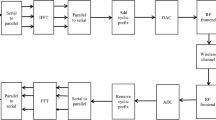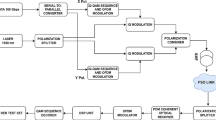Abstract
This paper proposes a new precoding approach that utilizes two-dimension (2D) Angle of Arrival (AOA) based precoding (beamforming) approach for multi-cell massive Multiple Input Multiple Output (m-MIMO) systems. The proposed approach enhances the performance of m-MIMO systems by overcoming pilot contamination that is caused by corrupted Channel State Information. It exploits the spatial properties of the propagated signals to distinguish between various users in the multi-cell m-MIMO system and selects the partial space for beamforming based on AOA information to suppress inter-cell and intra-cell interference. We mathematically analyze the impact of pilot contamination in the uplink training and determine the closed-form approximation of uplink Minimum Mean Square Error (MMSE) estimator. By using MMSE estimator as well as 2D AOA and channel estimation, a corresponding MMSE precoding which minimizes the effect of pilot contamination and improves the downlink achievable rate of the system is proposed. Furthermore, a comparison is made of the resolution between the various 2D AOA estimations for an m-MIMO and the optimum values closest bound for the proposed precoding was chosen to reduce pilot contamination. The performance of the proposed MMSE precoding based on 2D AOA estimation methods: 2D Unitary Estimation of Signal Parameters via Rotational Invariance Techniques (2D UESPRIT), 2D Fourier Domain Line Search MUSIC (2D FDLSM), and 2D Propagator Method (2D PM)) were evaluated and compared with pilot contaminated system and deterministic MMSE precoding in terms of their respective achievable rate. Simulation results reveal that the achievable sum rate gains of 2D UESPRIT, 2D FDLSM, and 2D PM based precoding which achieved 97.6%, 92.4%, 86.3% of the desired deterministic performance, respectively, compared to pilot contaminated system, which achieved only 90% even when in the best case of having only one contaminated user out of all users within the activated cell. Findings from our research indicate the feasibility of utilizing the AOA based beamforming to reduce pilot contamination effect that is inherent in a larger order m-MIMO system for the Fifth Generation (5G) wireless transmissions.








Similar content being viewed by others
References
Ali, E., Ismail, M., Nordin, R., & Abdulah, N. F. (2017). Beamforming techniques for massive MIMO systems in 5G: overview, classification, and trends for future research. Frontiers of Information Technology & Electronic Engineering,18(6), 753–772.
Bjornson, E., Larsson, E. G., & Marzetta, T. L. (2016). Massive MIMO: Ten myths and one critical question. IEEE Communications Magazine,54(2), 114–123.
Ma, J., Zhang, S., Li, H., Zhao, N., & Leung, V. C. M. (2018). Interference-alignment and soft-space-reuse based cooperative transmission for multi-cell massive MIMO networks. IEEE Transactions on Wireless Communications,17(3), 1907–1922.
Flordelis, J., Rusek, F., Tufvesson, F., Larsson, E. G., & Edfors, O. (2017). Massive MIMO performance-TDD versus FDD: What do measurements say? arXiv preprint arXiv:1704.00623.
Mazlan, M. H., Ali, E., Ramly, A. M., Nordin, R., Ismail, M., & Sali, A. (2018). Pilot decontamination using coordinated wiener predictor in massive-MIMO system. IEEE Access,1, 1.
Marzetta, T. L., Larsson, E. G., Yang, H., & Ngo, H. Q. (2016). Fundamentals of massive MIMO. Cambridge: Cambridge University Press.
Mazlan, M. H., Behjati, M., Nordin, R., & Ismail, M. (2017). Wiener-based smoother and predictor for massive-MIMO downlink system under pilot contamination. Telecommunication System,1, 1–13.
Fernandes, F., Ashikhmin, A., & Marzetta, T. L. (2013). Inter-cell interference in noncooperative TDD large scale antenna systems. IEEE Journal on Selected Areas in Communications,31(2), 192–201.
Zheng, X., et al. (2015). An efficient pilot scheme in large-scale two-way relay systems. IEEE Communications Letters,19(6), 1061–1064.
Ullah, S. M. S., Mahyiddin, W. A., Zakaria, N. A., Latef, T. A., Noordin, K. A., & Dimyati, K. (2019). Training size optimization with reduced complexity in cell-free massive MIMO system. Wireless Networks,25(4), 1983–1994.
Müller, R. R., Cottatellucci, L., & Vehkaperä, M. (2014). Blind pilot decontamination. IEEE Journal of Selected Topics in Signal Processing,8(5), 773–786.
Cottatellucci, L., Muller, R. R., & Vehkapera, M. (2013) Analysis of pilot decontamination based on power control. In 2013 IEEE 77th Vehicular Technology Conference (VTC Spring) (pp. 1–5).
Wang, H., Pan, Z., Ni, J., & Chih-Lin, I. A spatial domain based method against pilot contamination for multi-cell massive MIMO systems. In Communication Networking China (CHINACOM), 2013 8th International ICST Conference (pp. 218–222).
Yin, H., Cottatellucci, L., Gesbert, D., Muller, R. R., & He, G. (2015). Pilot decontamination using combined angular and amplitude based projections in massive MIMO systems. In IEEE International Workshop on Signal Processing Advances in Wireless Communications SPAWC (Vol. 2015–August, pp. 216–220).
Ali, E., Abdullah, N. F., Ismail, M., Nordin, R., Mahzan, M. H., & Balfaqih, M. (2019). 2D-AOA Estimation and Tilt Angle Adaptation for 3D Beamforming Interference Reduction in Massive MIMO. In IEEE 89th Vehicular Technology Conference (VTC2019-Spring) (pp. 1–5).
Shang, G., & Li, H. (2015). Spatial domain method based on 2D-DoA estimation against pilot contamination for multi-cell massive MIMO systems. International Conference on Wireless Communications & Signal Processing (WCSP),2015, 1–5.
Zhang, Z., Teh, K. C., & Li, K. H. (2015). Performance analysis of two-dimensional massive antenna arrays for future mobile networks. IEEE Transactions on Vehicular Technology,64(11), 5400–5405.
Iqbal, B., & Umar, R. (2017). 2D DOA estimation algorithm for massive MIMO using propagator method. International Journal of Future Computer and Communication,10(7), 13–24.
Lonkeng, A. D., & Zhuang, J. (2017). Two-dimensional DOA estimation using arbitrary arrays for massive MIMO systems. International Journal of Antennas and Propagation,2017, 1.
Wang, T., Ai, B., He, R., & Zhong, Z. (2015). Two-dimension direction-of-arrival estimation for massive MIMO systems. IEEE Access,3, 2122–2128.
Ali, E., Ismail, M., Nordin, R., & Abdulah, N. F. (2019). Beamforming with 2D-AOA estimation for pilot contamination reduction in massive MIMO. Telecommunications Systems (pp. 1–12)
Li, X., Bjornson, E., Larsson, E. G., Zhou, S., & Wang, J. (2017). Massive MIMO with multi-cell MMSE processing: exploiting all pilots for interference suppression. EURASIP Journal on Wireless Communications and Networking,2017, 1.
Gupta, A., & Jha, R. K. (2019). Power optimization with low complexity using scaled beamforming approach for a massive MIMO and small cell scenario. Wireless Networks,1, 1–12.
Bjornson, E., Hoydis, J., & Sanguinetti, L. (2018). Massive MIMO Has Unlimited Capacity. IEEE Transactions on Wireless Communication,17(1), 574–590.
Ustok, R. F., Dmochowski, P. A., Smith, P. J., & Shafi, M. (2018). Interference cancellation with jointly optimized transceivers in multiuser multicellular networks. IEEE Transactions on Vehicular Technology,67(8), 7219–7229.
Ashikhmin, A., Li, L., & Marzetta, T. L. (2018). Interference reduction in multi-cell massive MIMO systems with large-scale fading precoding. IEEE Transactions on Information Theory,64(9), 6340–6361.
Björnson, E., Hoydis, J., & Sanguinetti, L. (2017). Massive MIMO networks: Spectral, energy, and hardware efficiency. Foundations and Trends® Signal Processing,11(3–4), 154–655.
Hu, A. (2016). DOA-based beamforming for multi-cell massive MIMO systems. Journal of Communication Networks,18(5), 735–743.
Kamga, G. N., Xia, M., & Aïssa, S. (2017). Spectral-efficiency analysis of regular-and large-scale (massive) MIMO with a comprehensive channel model. IEEE Transactions on Vehicular Technology,66(6), 4984–4996.
Minango, J., & de Almeida, C. (2019). Hyper-power zero forcing detector for massive MIMO systems. Wireless Networks,1, 1–9.
Yin, H., Fellow, D. G., Filippou, M., & Liu, Y. (2013). A coordinated approach to channel estimation. IEEE Journal on Selected Areas in Communications,31(2), 264–273.
Molisch, A. F. (2011). Wireless communications (2nd ed.). New York: Wiley.
Amin, B. S., Ibrahim, A. S., Ismail, M. H., & Mourad, H.-A. M. (2018). Precoding and power allocation algorithms for device-to-device communication in massive MIMO networks. Wirel. Networks,24(3), 925–942.
Björnson, E., Bengtsson, M., & Ottersten, B. (2014) Optimal multiuser transmit beamforming: A difficult problem with a simple solution structure. arXiv Prepr. arXiv:arXiv1404.0408.
Anderson, S. (1993). On optimal dimension reduction for sensor array signal processing. Signal Processing,30(2), 245–256.
Author information
Authors and Affiliations
Corresponding author
Additional information
Publisher's Note
Springer Nature remains neutral with regard to jurisdictional claims in published maps and institutional affiliations.
Rights and permissions
About this article
Cite this article
Ali, E., Ismail, M., Abdullah, N.F. et al. Two dimension angle of arrival-based precoding for pilot contamination reduction in multi-cell massive MIMO systems. Wireless Netw 26, 4129–4147 (2020). https://doi.org/10.1007/s11276-020-02315-1
Published:
Issue Date:
DOI: https://doi.org/10.1007/s11276-020-02315-1




